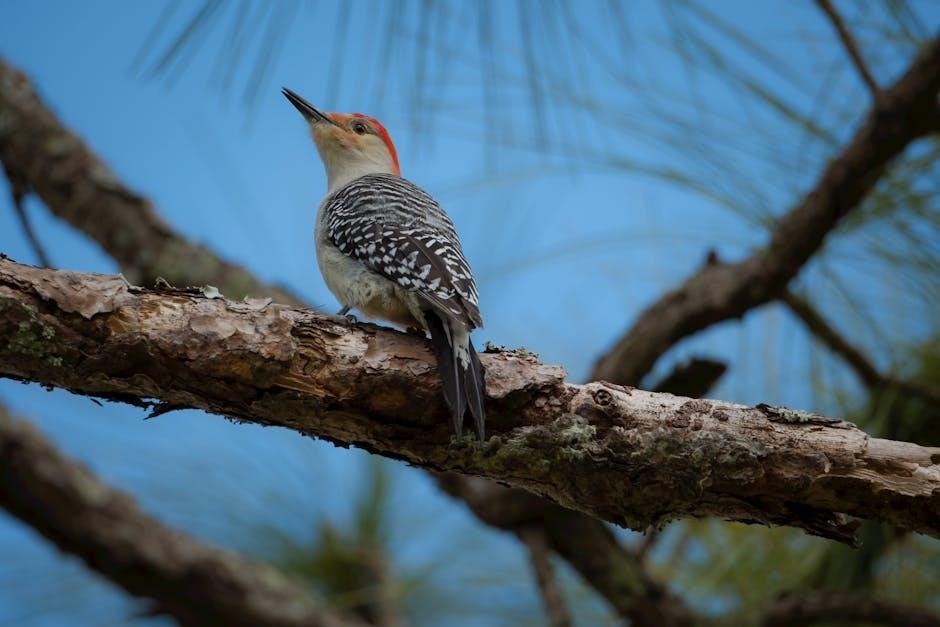Identifying Florida’s trees is crucial for understanding the state’s biodiversity. It helps in conservation efforts, landscape design, and appreciating the natural beauty. Correct identification aids in managing forests and urban green spaces effectively.
Importance of Tree Identification in Florida
Tree identification in Florida is paramount for several reasons. Firstly, it is essential for effective conservation management, as understanding which species thrive where allows for targeted protection efforts. Recognizing native trees supports biodiversity and helps maintain ecological balance, crucial in a state with diverse ecosystems. Moreover, accurate identification aids in preventing the spread of invasive species, which can outcompete native flora and disrupt natural habitats.
Furthermore, tree identification is vital for urban planning and landscaping, ensuring the selection of appropriate species for specific environments. Identifying trees also plays a role in forestry, land management and appreciating the natural heritage of Florida.
Finally, knowledge of tree species enhances our appreciation of Florida’s natural environment and promotes responsible stewardship of its resources.
Overview of Florida’s Diverse Tree Species
Florida boasts a remarkable variety of tree species, reflecting its diverse climate and geography. From the subtropical south to the more temperate panhandle, different regions support unique arboreal communities. Native trees include iconic species like pines, oaks, and cypress, adapted to the state’s sunshine, humidity, and coastal conditions. Mangroves thrive along the coasts, providing critical habitat and protection from erosion.
Deciduous trees such as maples, ashes, and basswoods are also common, especially in northern Florida. The state is home to many fruit trees, palms, and gum trees. Understanding this diversity requires familiarity with key identifying features.
This guide explores the most common and ecologically significant tree species found throughout Florida.

Common Tree Families in Florida
Pine Trees (Pinus species)
Florida is home to several pine species, crucial for timber and wildlife habitat. These pines are adapted to sandy soils and periodic fires, playing a vital ecological role.
Pine Trees (Pinus species)
Pine trees are a dominant presence in Florida’s diverse ecosystems, particularly in the Florida Panhandle region. These trees are well-adapted to the state’s sandy soils and play a crucial role in supporting various wildlife species. Identifying pines involves observing needle arrangements, cone shapes, and bark patterns. Common species include the Longleaf Pine, Slash Pine, and Loblolly Pine.
The Longleaf Pine is known for its long needles in bundles of three and its fire-resistant bark. Slash Pine is characterized by its relatively shorter needles and smaller cones. Loblolly Pine is recognized by its fast growth and adaptability to different soil types. These pines contribute significantly to Florida’s timber industry and ecological balance. Understanding their specific traits is essential for proper identification.
Oak Trees (Quercus species)
Oak trees are a diverse and ecologically significant group in Florida, with numerous species adapted to various habitats. Identifying oaks involves examining leaf shape, acorn characteristics, and bark texture. Live Oak, Water Oak, and Laurel Oak are among the most common. Live Oaks are renowned for their sprawling canopies and evergreen leaves, often draped with Spanish moss.
Water Oaks are deciduous with lobed leaves, typically found in moist areas. Laurel Oaks have lance-shaped leaves and are semi-evergreen, retaining foliage through mild winters. Oak trees provide crucial habitat and food sources for wildlife. Furthermore, they contribute to the aesthetic appeal of Florida’s landscapes. Accurate oak identification is vital for conservation and landscape management efforts throughout the state.
Cypress Trees (Taxodium species)
Cypress trees are iconic wetland inhabitants of Florida, primarily represented by the Bald Cypress (Taxodium distichum). These deciduous conifers are adapted to thrive in flooded conditions, often forming distinctive “knees” protruding from the water. Bald Cypress identification relies on feathery leaves that turn bronze in the fall before shedding. The bark is fibrous and reddish-brown, adding to their unique appearance.
Pond Cypress (Taxodium ascendens) is another species, typically found in shallower, more stagnant waters. Cypress trees play a vital role in wetland ecosystems, providing habitat for various wildlife and filtering water. Their presence indicates healthy aquatic environments. Distinguishing between Bald Cypress and Pond Cypress requires careful examination of leaf and cone characteristics. These trees contribute significantly to Florida’s ecological diversity and scenic beauty.

Key Features for Tree Identification
Identifying trees involves observing key characteristics. These include leaf shape and arrangement, bark texture, and the presence of flowers or fruits. Each feature provides clues to determine a tree’s species.
Leaf Characteristics (Shape, Arrangement, Margins)
Leaf characteristics are fundamental for tree identification. Start by noting the leaf shape, whether it’s needle-like, oval, lobed, or palmate. Observe the leaf arrangement on the branch: is it alternate, opposite, or whorled? Alternate leaves appear staggered, opposite leaves grow in pairs, and whorled leaves have three or more leaves at a node.
Next, examine the leaf margins. Are they smooth (entire), toothed (serrate), lobed, or spiny? The presence and type of teeth along the edge can be crucial. Also, consider the leaf’s texture – is it smooth, rough, hairy, or waxy? Leaf size and color variations can also aid in identification. Combine these observations for a more accurate assessment. Noticing these details assists pinpointing the tree type.
Bark Identification
Bark identification is a valuable skill in tree identification, especially during winter when leaves are absent. Begin by observing the bark’s color, ranging from shades of gray and brown to red and even green. Note the texture: is it smooth, rough, furrowed, scaly, or peeling? Furrowed bark has deep grooves, while scaly bark features small, plate-like pieces.
Consider the pattern of the bark. Does it have vertical ridges, horizontal lenticels (small pores), or diamond-shaped patterns? Peeling bark might come off in strips, plates, or curls. The thickness of the bark can also be a clue. Older trees often have thicker, more distinctive bark patterns. Use a field guide to compare your observations with known bark characteristics. Combine bark features with other clues for reliable tree identification.
Flower and Fruit Identification
Identifying trees by their flowers and fruits offers a seasonal but reliable method. Note the flower’s color, size, shape, and arrangement. Are the flowers solitary or in clusters like catkins or panicles? Observe the number of petals or flower parts. Is the tree dioecious (separate male and female trees) or monoecious (both sexes on one tree)?
Fruit identification involves noting the type: is it a berry, drupe, pome, legume, or nut? Consider the fruit’s color, size, shape, texture, and the presence of any distinctive features like wings or spines. Note when the tree flowers and fruits, as timing can be crucial. Compare your observations with field guide descriptions and images. However, remember that some trees may not flower or fruit every year, adding complexity to identification.

Resources for Florida Tree Identification
Numerous field guides and books are available to aid in Florida tree identification. These resources provide detailed descriptions, illustrations, and photographs to assist in accurate identification. Look for guides specific to Florida.
Field Guides and Books
For accurate Florida tree identification, field guides and books are invaluable resources. “Forest Trees of Florida,” a standard handbook since 1925, offers detailed descriptions and illustrations. These guides often include information on leaves, bark, flowers, and fruits, making identification easier. Many tropical and subtropical plants found in the Caribbean have their northern limit in South Florida, so look for comprehensive guides.
Consider guides with full-color photographs of leaves, bark, and flowers. These visual aids, coupled with clear descriptions, simplify the identification process. Ensure the guide covers both common and scientific names of the tree species. Books tailored to Florida’s diverse tree species will greatly assist in your identification journey.
Online Databases and Tools
Numerous online databases and tools exist to aid in Florida tree identification, offering accessible information and resources. These platforms often feature extensive collections of images, descriptions, and distribution maps for various tree species found in Florida. Many allow you to search by characteristics such as leaf shape, bark texture, or flower type, narrowing down potential matches.
Some tools are specifically designed for projects in Florida and the southeastern United States, considering hardiness zones 8-11. Interactive keys and mobile apps provide convenient, on-the-go identification capabilities. These digital resources enhance the tree identification process, offering detailed information and visual aids to users of all levels.

Native vs. Invasive Species
Distinguishing between native and invasive tree species is vital for maintaining Florida’s ecological balance. Invasive species can outcompete native trees, disrupting ecosystems and reducing biodiversity within the state.
Identifying Invasive Tree Species
Identifying invasive tree species in Florida is crucial for conservation efforts. Many invasive trees, like the Brazilian Pepper Tree, threaten native ecosystems. Accurate identification is the first step in managing and controlling their spread. Look for trees that exhibit rapid growth, dense foliage, or unusual characteristics compared to local flora.
Pay attention to trees with aggressive root systems or those that readily produce numerous seeds. Utilize field guides and online resources to compare suspected invasive species with known native trees. Report any suspected invasive species to local authorities to facilitate effective management strategies. Early detection and prompt action are essential to protect Florida’s natural habitats from the harmful effects of invasive trees. Remember to document your findings with photographs and detailed notes.